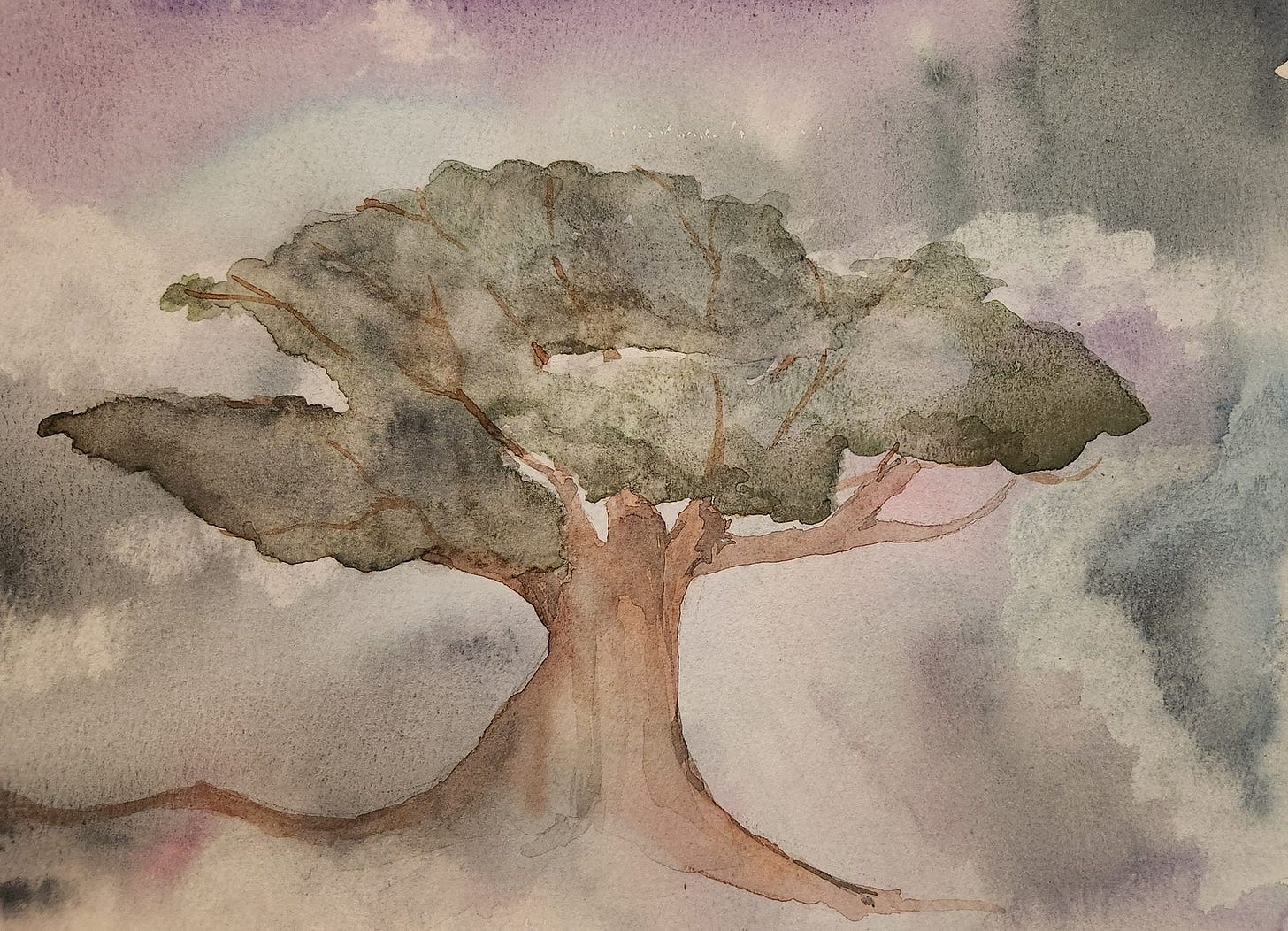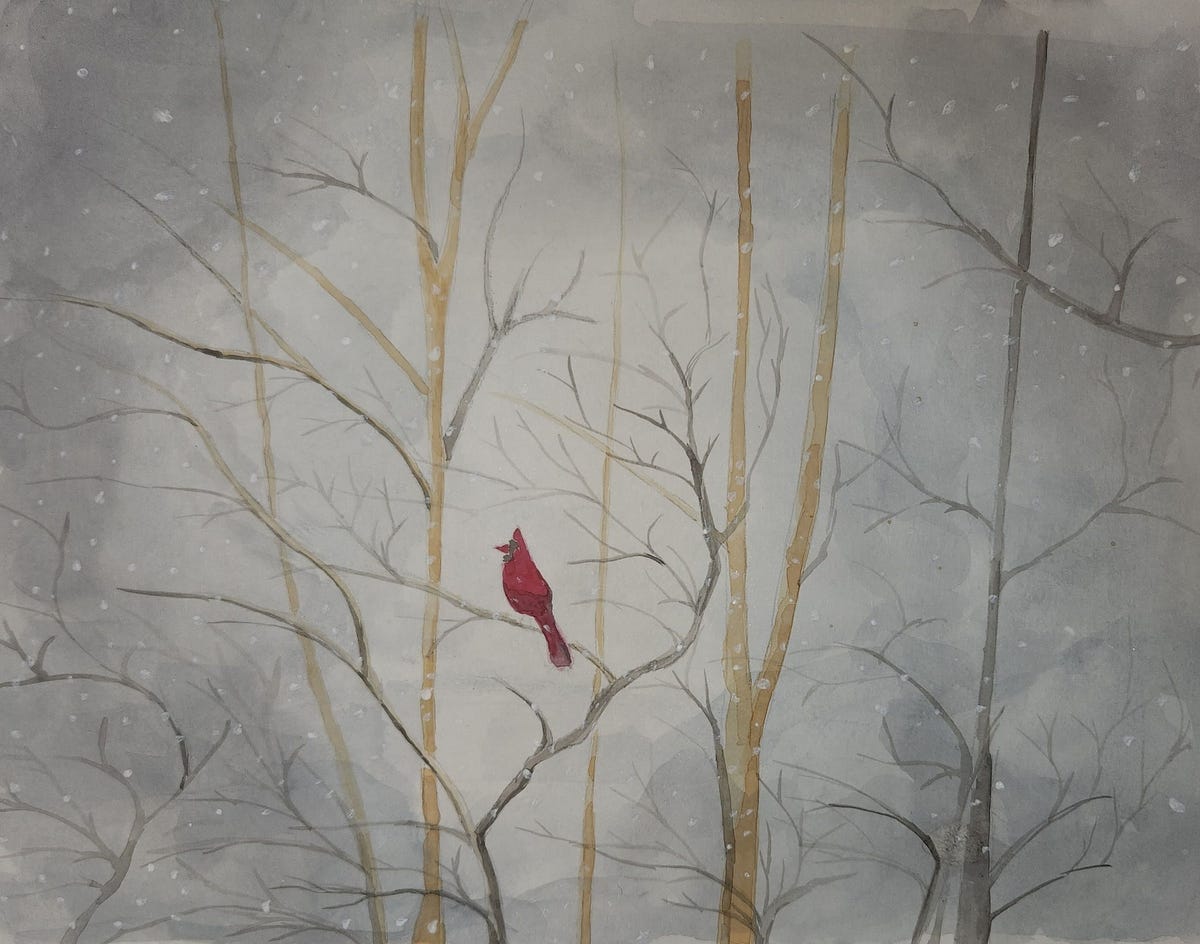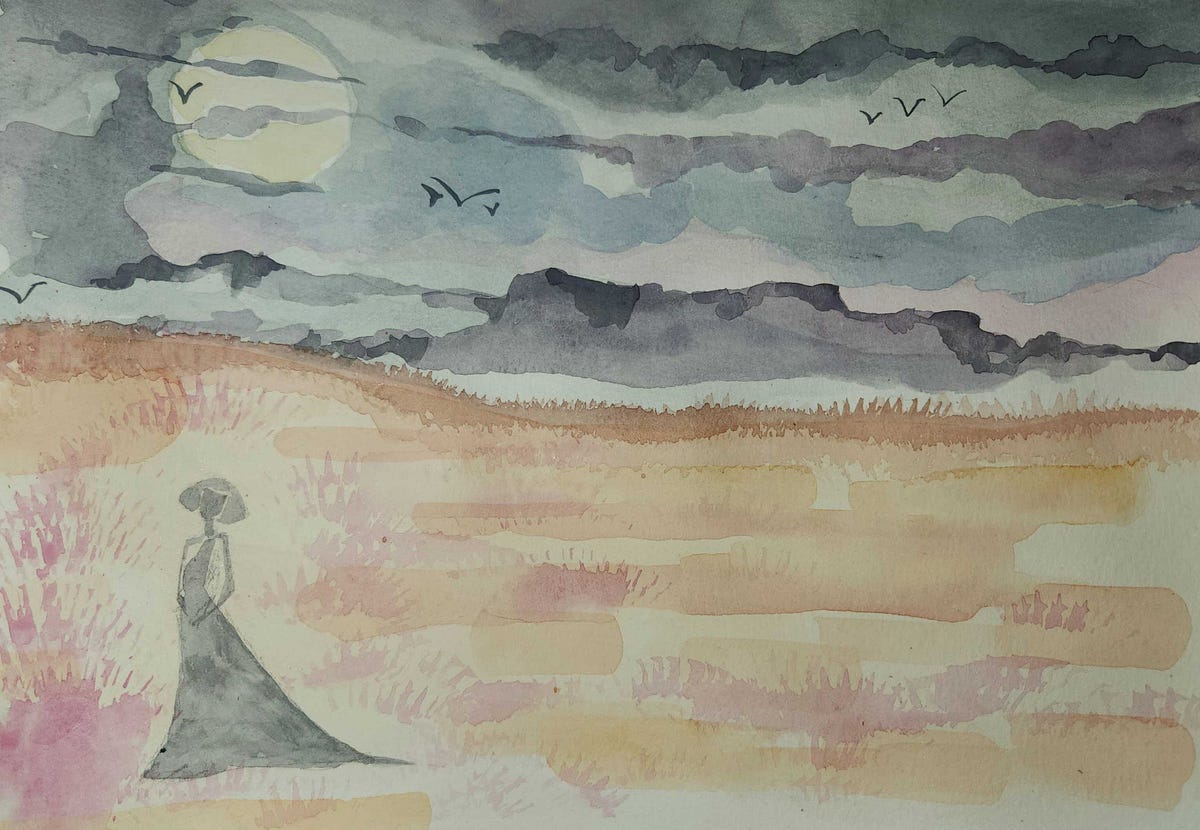Learning to paint while the world burns
Expectations versus reality
“I am riddled with anxiety,” I tell my therapist on Wednesday when he asks how I’m doing. “Turning off social media is easier said than done. Skipping the updates from my favorite political podcasts, clicking away from the video thumbnails of the latest catastrophe — it’s all so hard to ignore. It feels selfish not to pay attention. Precarious.”
“I hear you,” he says, than gently asks if there is anything that helps, any way to give myself a break.
“I’m learning how to paint with watercolor,” I tell him. “It feels a bit absurd, given everything that’s going on right now.”
But my therapist nods approvingly. As always, he is completely supportive of any activity that provides a bit of respite from the pressure I’m constantly putting on myself.
I don’t tell him that painting feels like a copout to me. Anything that doesn’t keep me fixated on the current spiraling of American democracy seems self indulgent.
Maybe my therapist doesn’t struggle with guilt the way I do. I don’t ask him this. Instead, I explain that learning to paint, while frustrating, feels a bit like rebellion to me. “Attempting to make something beautiful despite the terrible things happening to our government is a bit of a ‘fuck you’ to the current administration.”
He nods. Wisely? Knowingly? He is like a human Rorschach test. I see what I want to see.
“Watercolor is hard,” I say. That’s how we end the session.
It is three days later, a quiet Saturday morning. The sun has just come up. My husband and daughter are still asleep. It is the perfect time to paint.
Two whole days stretch before me with nothing scheduled, nowhere to go, so much potential. That’s what the plain white watercolor paper offers me after I tape it down to the board — endless potential.
I place two full cups of clean water beside me along with a bamboo container of brushes. I have too many brushes. I can’t resist them when I go to my local art supply store, lined up, bristles out, neatly sorted in special shelves with spaces built specifically for each slender handle.
I have a tremendous amount of paint, plastic containers filled with multi-colored cakes and a half dozen tubes — lemon yellow, cobalt blue, magenta. I only recently started buying paint in tubes because my friend Chris, who is very good at painting, suggested that I needed more pigment in my washed out skies and faded mountains.
The dry cakes weren’t cutting it as far as color saturation goes, but I kept using them because I was insecure. The tube paints are much more vibrant, more pigmented. It gives me a thrill to mix them, but it also scares me. Darker colors mean it’s easier for me to screw up.
I am more confident than I was a month ago. Thirty straight days of painting has helped me become bolder. I buy a palette box to mix the tube paints in. I’ve been wanting it for weeks, but it is $26 at Michael’s and that feels extravagant given that I am always broke.
I have things I want to create, visions of stormy skies, trees with intricate branches, the understory of a forest with its moss and its rocks and its colorful mushrooms.
I mix the paint with so much hope, spread the water across my 100% cotton paper, saturate the size 6 paintbrush first with water, then with color. I take a fat square brush and dunk it into clean water, then pull it across the paper until the surface is wet. Now the clock is ticking.
I will myself to paint the picture I see in my head.
Blooms of blue and gold and violet blossom and mix. I dab white clouds across the surface with a paper towel. I want clarity. I want the transparent colors to allow just enough paper through so it looks like the sky glows. I want this painting to be magical. For a few seconds it is, but then the sky turns green and brown when colors meet where they shouldn’t. I groan.

My friend Chris whose skies are perfectly stormy, whose trees are rich with shadow and texture, who gets the perspective of his buildings just right, tells me I need to simplify. I’ve show him yet another failed landscape.
“Use one color,” he says. “Get the values down first. All you need is Payne’s gray. Don’t overwork it.”
But I’m impatient. I want to use all the colors. I want them to blend together perfectly the way they do in my head. It’s a fevered need — to effortlessly create the tree, the sky, the bird, the lovely dreamscape that only I can see.
If I succeed at this, then all the terrible things happening in the world will be easier to bear. I want to make something beautiful, but all I’m getting is mud.
I tell myself to stop watching the news, stop scrolling the feeds, stop checking in with my friend who works for the government. “It’s all terrible,” she says and my head hurts, my heart aches.
“Take a break from the news for just a couple of days,” my mother tells me. She is retired and struggles with chronic health issues.
She draws colorful pictures of birds and berries and forest creatures on a laptop my father bought for her. The arthritis in her hands makes it hard for her to push pencil against paper, but she can hold the stylus. She can move it lightly across the screen. She can still turn nothing into something.
“Okay,” I say, but I watch YouTube on my phone at 11 pm, when the house is quiet. I see planes falling. I see ICE officers dragging people from their homes. I see the smug smiles of billionaires with unlimited power. I see LA on fire.
I put on some music, get the paint out, tape the paper to the board. I learn how to paint Koi fish from a British man on YouTube. His voice is calm, reassuring. “It doesn’t have to be perfect,” he says. But I want it to be perfect. I do.
I keep painting the same things — trees, mountains, skies with a not-so perfect circle of sun or moon, a smattering of birds. The birds are tiny V’s on the paper.
“Don’t overwork it,” I whisper Chris’s words at the paper. But I dab the birds too aggressively and their wings blur. I move too slowly and color blooms where it shouldn’t. I miss a hard line, and it ruins the softness of the sky. Another failure.
Watercolor is a fast medium. I’m amazed at how the paper is empty one second and filled with color the next. You have to work quickly. You have to understand how the paint interacts with the brush and the paper and the water. You have to step away before you’re completely done.
Lifting paint off the paper is part of the process. Gravity is part of the process. You can layer color on top of color, but only if you wait for each layer to dry, otherwise you get mud. Well, I get mud. Maybe you’re better at this than me.
My daughter paints in oil. She doesn’t understand why I bother with watercolor. “Oil is forgiving,” she tells me. “Oil lets you work it and rework it forever.” She’ll work on a painting for months. She’ll make entire figures appear and disappear over and over again on the same canvas.
But watercolor is unforgiving. It’s ruthless. It’s willful and untamed.
“I think it’s beautiful,” I tell her. “When you get it right.” I rarely get it right.
I clean up every night when I’m done painting. It’s become a ritual. Wash the brushes, wash the cups, clean out the palette. I carefully remove the painter’s tape and free my painting from its board.
If I don’t hate what I’ve created, I share it on Facebook. I usually post photos of birds and trails and mushrooms. Now it’s just painting after mediocre painting.
I’m trying to stay off of these platforms, but I can’t help myself. I want to share. I’m excited when I finally get a tree right. I’m overjoyed when a sky looks stormy. It feels wonderful to do something completely pointless, something attached to nothing, something that takes my mind away from worrying about the world.
“I have a stack of terrible paintings,” I tell Chris sadly. “What do I do with all of this?”
“Save them. Put them in a book. Keep notes on what you’ve learned. Revisit them at the end of the year. You’ll be amazed.”
I’m skeptical that I’ll get any better, but I’ve stopped throwing out the bad paintings. I’m trying to be more patient. I’ve become slightly obsessed.
Sundays are for folding laundry. They’re for planning the week’s tasks. They’re for painting skies. I’m lucky I have so so many artists in my life. We text each other our work. We trade ideas. We talk about color and composition. This is much better than talking about the news.
There are worse ways to spend my time during a gloomy winter as our tenuous hold on democracy continues to slip away. And, as it turns out, Chris is right. I am getting a tiny bit better with every mediocre painting.
The biggest thing I’ve learned? If you try to force watercolor to do what you want, you will fail. That’s a hard lesson to accept for a control freak like me. Surrendering to paint and water and pigment is how you get the beauty from watercolor. I’m looking forward to sharing this insight with my therapist when we meet again next week.









Lovely piece. I've come to realize that surrendering is actually a brave and beautiful thing. And that beauty is abundant in every day life if you know where to look. That's why I named my publication Distracted by Pretty Things, because I always am. Thanks for sharing.
I rarely leave comments on social media, this might be my second time? I think your paintings are absolutely EXTRAORDINARY. I love love your artistic voice. I would dream of having some of these up in my house. So beautiful, so moving, just stunning. (Just like your writing is as well.) Sending love from the mama of a 3 year neurodivergent daughter ❤️